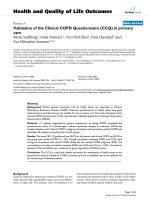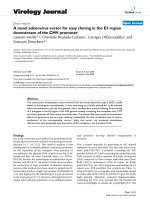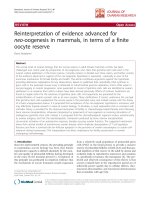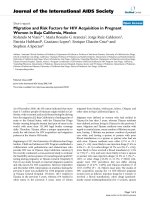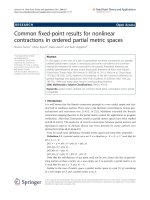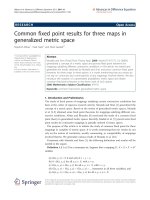Báo cáo hóa học: " Editorial Signal Processing Technologies for Ambient Intelligence in Home-Care Applications" docx
Bạn đang xem bản rút gọn của tài liệu. Xem và tải ngay bản đầy đủ của tài liệu tại đây (1.17 MB, 3 trang )
Hindawi Publishing Corporation
EURASIP Journal on Advances in Signal Processing
Volume 2007, Article ID 91730, 3 pages
doi:10.1155/2007/91730
Editorial
Signal Processing Technologies for Ambient Intelligence in
Home-Care Applications
Francesco G. B. De Natale,
1
Aggelos K. Katsaggelos,
2
Oscar Mayora,
3
and Ying Wu
2
1
Department of Information and Communication Technology, University of Trento, Via Sommarive 14, 38050 Trento, Italy
2
Department of Electrical and Computer Engineering, Northwestern University, 2145 Sheridan Road, Evanston, IL 60208-3118, USA
3
Multimedia, Interaction and Smart Environments Group, Create-Net International Research Center, Via Solteri 38,
38100 Trento, Italy
Received 22 March 2007; Accepted 22 March 2007
Copyright © 2007 Francesco G. B. De Natale et al. This is an open access article distributed under the Creative Commons
Attribution License, which permits unrestricted use, distribution, and reproduction in any medium, provided the original work is
properly cited.
The possibility of allowing elderly and people with different
kinds of disabilities to conduct a normal life at home and to
achieve a more effective inclusion in the society is attracting
more and more interest from both industrial and govern-
mental bodies (hospitals, healthcare institutions, and social
institutions).
Ambient intelligence technologies, supported by ade-
quatenetworksofsensorsandactuators,aswellasbysuitable
processing and communication technologies, could be one of
the enabling factors to achieve such an ambitious objective.
Recent researches demonstrated the possibility of provid-
ing constant monitoring of environmental and biomedical
parameters, and the possibility to autonomously originate
alarms, provide primary healthcare services, activate emer-
gency calls, and rescue oper a tions through distributed assis-
tance infrastructures. Furthermore, proactive systems help
the user to perform daily activities, stimulating a more ac-
tive and healthy lifestyle, and supporting functional rehabili-
tation and preservation processes.
Although some products are already appearing on the
market, several technological challenges connected with
these applications are still open, ranging from the develop-
ment of enabling technologies (hardware and software) to
the standardization of interfaces, the development of intu-
itive and ergonomic human-machine interfaces, and the in-
tegration of complex systems in a highly multidisciplinary
environment.
The objective of this special issue is to collect the
most significant contributions and visions coming from
both academic and applied research bodies working in this
stimulating research field. This is a highly interdisciplinary
field comprising many areas, such as signal processing, image
processing, computer vision, sensor fusion, machine learn-
ing, pattern recognition, biomedical signal processing, mul-
timedia, human-computer interfaces, and networking. The
focus is primarily on ambient intelligence and home automa-
tion technologies, considered as basic tools to build smart
environments providing advanced home-care services.
The possibility of continuously monitoring the elderly
and automatically detecting emergency situations clearly
represents one of the priorities in home-care. The paper
“Event detection using “variable module graphs” for h ome
care applications,” by Amit Sethi et al. proposes a new
paradigm to better exploit ubiquitous audio-visual capture
devices used in home-care applications, with a special focus
on surveillance and complex event detection. Their approach
relies on variable/module (V/M) graphs, a recent extension
of factor graphs. V/M graphs are used to bridge the seman-
tic gap between the huge amount of data produced by the
capture devices and the useful high-level concepts to be elab-
orated by the vision system. From the application viewpoint,
the primary objective is surveillance of location for subject
tracking as well as detection of irregular or anomalous be-
haviors. This is done automatically with minimal human in-
volvement, with the system being trained to raise an alarm
when an anomalous behavior is detected.
Similarly, the work by J S. Hu, and T M. Su, t itled “Ro-
bust background subtraction w ith shadow and highlight re-
moval for indoor surveillance,” tackles the problem of mon-
itoring a person in the home environment. In this case, the
2 EURASIP Journal on Advances in Signal Processing
authors concentrate on the robust detection of foreground
regions in complex indoor scenes, in the presence of illumi-
nation changes and dynamic backgrounds. These are typical
conditions in ambient-assisted living infrastructures, where
the environmental conditions cannot be strictly controlled,
and the false alarm rate can become high. Their proposed ap-
proach achieves a robust background subtraction by suitably
combining three models, namely the color-based probabilis-
tic background model (CBM, based on a Gaussian mixture
model), the gradient-based probabilistic background model
(GBM, based on the short-term and long-term CBMs), and
the cone-shape illumination model (CSIM, used to identify
shadows and highlights).
N. P. Cuntoor and R. Chellappa further emphasize the
behavioral analysis problem in their paper “Mixed-state
models for nonstationary, multiobject activities.” Here, the
objective is to model and segment human activities in order
to achieve a better knowledge on the actions performed by a
subject, and how such actions are performed. The method-
ology developed by the authors to pursue this goal relies
on a mixed state-space approach. The discrete-valued com-
ponent of the mixed state represents higher-level behavior,
while the continuous-state models the dynamics within be-
havioral segments. A set of behaviors is defined, based on
generic properties of motion trajectories, and is used to char-
acterize segments of activities. A Viterbi-based algorithm is
used to detect boundaries between segments. The usefulness
of the proposed approach for temporal segmentation and
anomaly detection is illustrated in different contexts, includ-
ing the UCF database of human actions.
If technologies enabling a timely response to harm-
ful events are important, the possibility of preventing such
events through an early analysis of dangerous behaviors
wouldbeevenmoreattractive.Thepaper“ThePARAChute
project: remote monitoring of posture and gait for fall pre-
vention,” by David J. Hewson et al. describes the results
achieved w ithin a joint research project named PARAChute
(Personnes
ˆ
Ag
´
ees et Risque de Chute), whose primary aim
was to develop a methodology that enables the detection of
an increased risk of falling in community-dwelling elderly.
The main goal is to provide a remote noninvasive assessment
for static and dynamic balance assessments and gait analysis.
This is achieved by using a combination of two tools: balance
assessment and gait analysis. The first is based on biome-
chanical tests (a force plate, providing a measure of the static
and dynamic equilibria), while the second makes u se of a vi-
sion system. The two subsystems perform local processing
and can be remotely interconnected to medical and support
networks.
Remote monitoring is also the main goal of the pa-
per “Real-time transmission and storage of video, audio,
and health data in energency and home care sitiuations,”
by Ivano Barbieri et al. In this case, the focus is put on
the efficient transmission of large-bandwidth streams of
audio-visual data for telemedicine applications (continuous
monitoring and emergency handling). The proposed mo-
bile communication system is based on the ITU-T H.323
multimedia terminal recommendation, suitable for real-time
data/video/audio and telemedical applications. The audio
and video codecs H.264 and G723.1, respectively, were im-
plemented and optimized in order to obtain high perfor-
mance on the system target processors. Furthermore, offline
media streaming, and storage and retrieval functionalities
were supported by integrating a relational database in the
hospital central system. A key aspect of the developed pro-
totype is the use of low-cost consumer electronics in order to
ease the market penetration of potential products.
Finally, the problem of assuring the privacy to endusers
is of fundamental import ance in hom-ecare applications,
which have to deal with extremely sensitive data such as per-
sonal video and voice, biomedical signals. This problem is
considered in the paper by Datong Chen et al. “Tools for pro-
tecting the privacy of specific individuals in video.” The au-
thors address two problems: first the automatic identification
of people with limited labelled data, and second the prob-
lem of obscuring a human body in the video with preserved
structure and motion information. The automatic identifi-
cation is achieved by a discriminative learning algorithm, us-
ing a robust face detection and tracking algorithm. The body
obscuration is implemented through a novel method, which
removes the appearance information of the people while pre-
serving rich structure and motion information. A prototype
system was tested in a nursing home environment, demon-
strating the possibility of minimizing the risk of exposing the
identities of protected people while ensuring the usability of
captured data for act ivity/behavior analysis.
We believe this issue will serve the readers well for many
years to come on this important application area.
Francesco G. B. De Natale
Aggelos K. Katsaggelos
Oscar Mayora
Ying Wu
Francesco G. B. De Natale received the Lau-
rea degree in electronic engineering in 1990,
and the Ph.D. degree in telecommunica-
tions in 1994, both from the University of
Genoa, Italy. In 1995-1996, he was a Visiting
Professor at the University of Trento, Italy,
and from 1996 to 1999, he was Assistant
Professor at the University of Cagliari, Italy.
At present, he is Full Professor of telecom-
munications at the University of Trento,
where he coordinates the didactic activities of the B.S. and M.S.
courses in telecommunications engineering. He is Deputy Head
of the Department of Information and Communication Tech-
nologies, where he leads the research activities of the Multimedia
Communications Lab. His research interests are focused on im-
age and signal processing, with particular attention to multime-
dia data compression, processing, and transmission. He was Gen-
eral Cochair of the Packet Video Workshop in 2000, and Technical
Program Cochair of the IEEE International Conference on Image
Processing (ICIP) in 2005 and of the Multimedia Services Access
Networks (MSAN) in 2005. He is also an Associate Editor of the
ACM/Springer Wireless Networks Journal from 2006. In 1998, he was
the corecipient of the IEEE Chester-Sall Best Paper Award. He is a
Senior Member of IEEE.
Francesco G. B. De Natale et al. 3
Aggelos K. Katsaggelos received the Dip-
loma degree in electrical and mechanical
engineering from the Aristotelian Univer-
sity of Thessaloniki, Greece, in 1979, and
the M.S. and Ph.D. degrees both in elec-
trical engineering from the Georgia Insti-
tute of Technology, in 1981 and 1985, re-
spectively. He is currently Professor of EECS
at Northwestern University, Director of the
Motorola Center for Seamless Communica-
tions, and a Member of the Academic Affiliate Staff at Evanston
Hospital. Dr. Katsaggelos is a member of the Publication Board
of the IEEE Proceedings and a number of additional publica-
tions. He is the editor of Digital Image Restoration (Springer-
Verlag, 1991), coauthor of Rate-Distortion Based Video Compres-
sion (Kluwer, 1997), coeditor of Recovery Techniques for Image and
Video Compression and Transmission, (Kluwer, 1998), coauthor of
Super-Resolution of Images and Video and Joint Source-Channel
Video Transmission (both Morgan & Claypool Publishers, 2007).
He is the co-inventor of twelve international patents, a Fellow of
the IEEE (1998), and the recipient of the IEEE Third Millennium
Medal (2000), the IEEE Signal Processing Society Meritorious Ser-
vice Award (2001), an IEEE Signal Processing Society Best Paper
Award (2001), and an IEEE ICBE Best Paper Award (2006). He
is a Distinguished Lecturer of the IEEE Signal Processing Society
(2006-07).
Oscar Mayora obtained his B.S. degree in
electronics and communications at Tec-
nol
´
ogico de Monterrey, Mexico, in 1991.
Later, he received an M.S. degree in com-
puter science in the same institute and a
Ph.D. degree in electronic engineering and
informatics at DIBE, University of Genoa,
Italy. In 2000, he joined the Advance Inter-
active Systems Laboratory at VTT Electron-
ics in Oulu, Finland, as an ERCIM Visit-
ing Research Fellow. In August 2001, he was appointed Associate
Professor in the Computer Science Department at Tecnologico de
Monterrey. In 2002, he became a Head of the Graduate Program In
Computer Science at the same institution. Since September 2004,
he is the Head of Multimedia, Interaction and Smar t Environments
Group in CREATE-NET International Research Center in Trento,
Italy. His main research interests are in technologies for ambient
intelligence and human-computer interaction.
Ying Wu received the B.S. degree from
Huazhong University of Science and Tech-
nology, Wuhan, China, in 1994, the M.S.
degree from Tsinghua University, Beijing,
China, in 1997, and the Ph.D. in elec-
trical and computer engineering from the
University of Illinois at Urbana-Champaign
(UIUC), Urbana, Ill, in 2001. From 1997
to 2001, he was a Research Assistant at
the Beckman Institute for Advanced Science
and Technology at UIUC. During summer 1999 and 2000, he was
a Research Intern with Microsoft Research, Redmond, Washing-
ton. Since 2001, he has been an Assistant Professor at the Depart-
ment of Electrical Engineering and Computer Science of North-
western University, Evanston, Ill. His current research interests in-
clude computer vision, image and video analyses, pattern recog-
nition, machine learning, multimedia data mining, and human-
computer interaction. He is an Associate Editor of SPIE Journal
of Electronic Imaging and an Associate Editor of IAPR Journal of
Machine Vision and Applications. He received the Robert T. Chien
Award at UIUC in 2001, and the NSF Career award in 2003. He is a
Senior Member of the IEEE.
